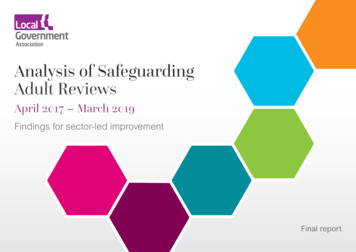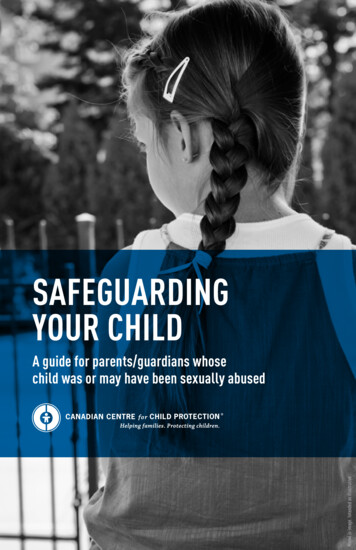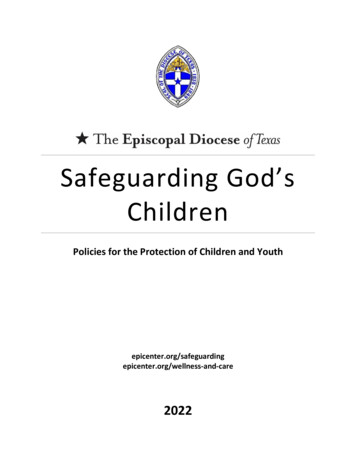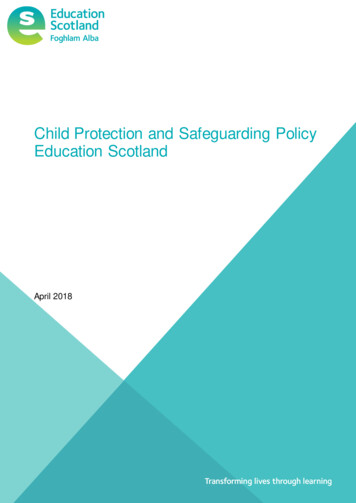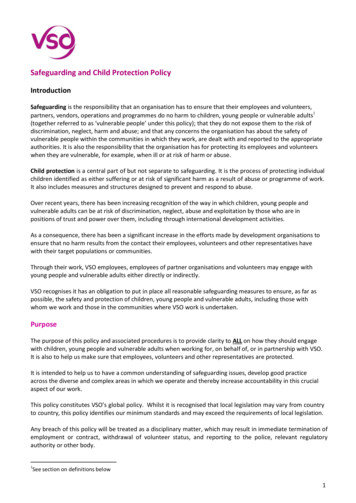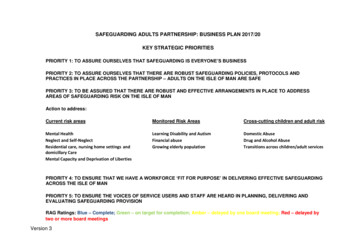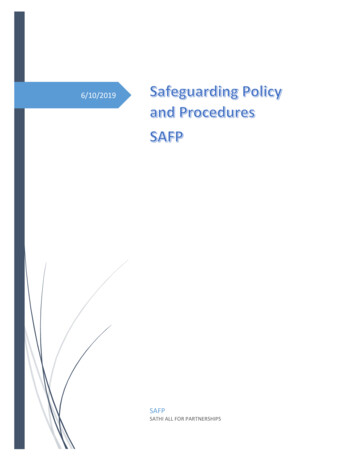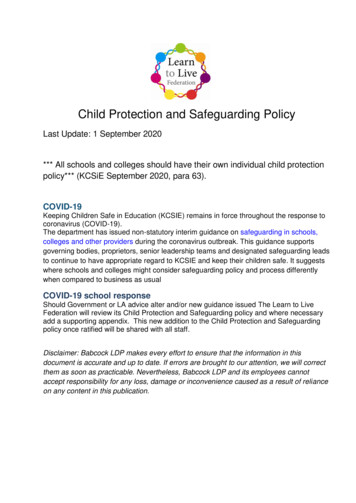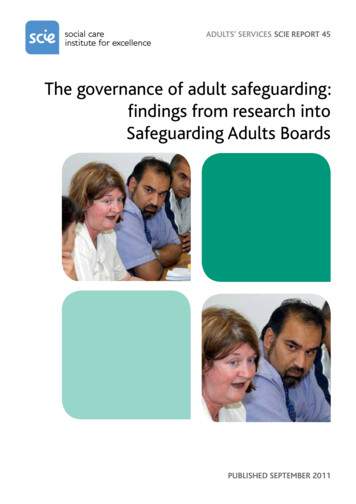
Transcription
ADULTS’ SERVICES SCIE REPORT 45The governance of adult safeguarding:findings from research intoSafeguarding Adults BoardsPUBLISHED SEPTEMBER 2011
ADULTs’ SERVICESADULTs’SCIE REPORTSERVICES45The governance of adult safeguarding:findings from research intoSafeguarding Adults BoardsSuzy Braye, University of SussexDavid Orr, University of SussexMichael Preston-Shoot, University of BedfordshireFinal Report to the Department of Healthi
First published in Great Britain in September 2011by the Social Care Institute for Excellence SCIE 2011All rights reservedWritten by Suzy Braye, David Orr and Michael Preston-ShootThis report is available onlinewww.scie.org.ukSocial Care Institute for ExcellenceFifth Floor,2–4 Cockspur Street,LondonSW1Y 5BHtel 020 7024 7650fax 020 7024 7651www.scie.org.ukFront cover photograph supplied by Photofusionpictures.orgiiThe governance of adult safeguarding
ContentsADULTs’SERVICESContentsExecutive summaryviKey findings summarised from the main reportMethodologyFindingsStrategic goals and purposeStructuresBoard membership and network patternsBoard functionsWhat accountabilities are engaged by the work of the Boards andhow are these expressed?Concluding observations on governance1122371114Part I: Introduction and methodology20151BackgroundA note on terminology20222Methodology2.1 Overall aims of the research2.2 Overview of data sources2.2.1 Systematic literature review2.2.2 Workshops2.2.3 Board documentation2.2.4 Key informant interviews2.2.5 Regional and national work programmes2.3 Ethical approval242424242525252626Part II: Research findings271Introduction272What are the strategic goals and purpose of Safeguarding Adults Boards?2.1 Definitions and scope2.1.1 Definitions and scope in Board documentation, workshops and keyinformant discussions2.1.2 Definitions and scope in the literature2.1.3 Summarising definitions and scope2.2 Strategy versus operations282828424346How are Boards structured?3.1 The relationship between form and function3.2 Sub-groups3.2.1 Horizontal differentiation3.2.2 Vertical differentiation3.2.3 Coordination5151535354603iii
3.3 Structural links beyond the Board3.3.1 Links with other partnerships3.3.2 Links beyond the Boards’ own localities4What are the patterns of Board and network membership?4.1 Interagency working: themes from the literature4.2 Findings on Board membership4.2.1 Agencies participating in membership4.2.2 Who the members should be4.2.3 Duties of membership4.2.4 The safeguarding manager’s relationship with the Board4.3 Chairing the Board4.3.1 Appointment of independent chairs4.3.2 Role specification4.3.3 Regional pictures4.4 Additional rules of engagement4.4.1 Frequency of meetings4.4.2 Quoracy4.4.3 Meeting protocols4.4.4 Budgets and financial regulation4.5 Participation on the Board by people who use services and carers4.5.1 The literature4.5.2 Board documentation4.5.3 Workshop 151161161195What do Boards do? How do they pursue their functions?5.1 Overview5.2 Strategic planning5.3 Setting standards and guidance5.4 Quality assurance5.4.1 General approaches to quality assurance5.4.2 Serious case reviews5.5 Promoting participation5.6 Awareness raising and publicity5.7 Capacity building and training5.8 Relationship management5.9 Monitoring the Board’s own performance in pursuing its functions1231231251261301301331421511521561576What accountabilities are engaged by the work of Boards and how are theseexpressed?6.1 Accountability6.2 Mechanisms for giving account: the annual report6.3 Board authority161161171173Concluding observations on governance7.1 Generic governance considerations7.2 Comparison across sectors7.3 Ways forward for adult safeguarding1761761811847iv626266The governance of adult safeguarding
ADULTs’ SERVICESReferences189Appendix 1: Overview of the literature reviewApproach takenSearchingScreeningScreening strategyScreening resultsKeywordingSynthesisCategorisation of the literature ppendix 2: Search terms and databases201Appendix 3: Search results – flow chart of processSearch results by database205205Appendix 4: Keywording strategy206Appendix 5: Review of Board documentationConstruction of the sampleDocumentation reviewed212212212v
Executive summaryThe research for this report explored the governance arrangements for safeguardingadults. Drawing on a systematic review of the literature, workshops attended bysafeguarding specialists, a survey of Safeguarding Adults Boards’ documentation,key informant interviews and data from regional and national safeguarding workprogrammes, the findings focus on five key features of Safeguarding Adults Boards.Strategic goals and purpose Boards engage in activities that are far wider than those implied by the currentdefinitions in No secrets (DH, 2000); from a core focus on protecting vulnerableadults from abuse, their work extends to community prevention and awarenessraising. The scope is potentially limitless, but some areas of risk are not routinelyencompassed – notably suicide and self-neglect.There was consensus that, in the context of personalisation, the languageof safeguarding should move away from an emphasis on vulnerability to aperspective that recognises the strengths and capabilities of an individual, andempowers their own decision making and self-protection.Boards commonly set out principles that underpin their work, emphasisingrespect for human rights, autonomy and empowerment, equality, proportionality,confidentiality and participation. Capacity is recognised as a key factor indetermining respect for autonomy of decision making.Structures Board structures must balance the need for a tightly defined core group ofsenior officers to provide strategic leadership, with the wish to be inclusive of awide range of stakeholders. Layered structures are common, with differentiationbetween strategic and operational responsibilities, and sub-groups takingresponsibility for distinct functions such as training and quality assurance (QA).Coordinating mechanisms – vertical channels of communication between layersin the hierarchy, and horizontal communication channels between sub-groups –are vital in maintaining a coherent and coordinated overall structure.Strategic links with other partnerships in a locality are an essential element ofa Board’s location within broader locality structures, although it is sometimesdifficult to ensure safeguarding is on the broader agenda. Some Boards also createstrong links outside their own area.Independent chairs network informally with each other, and regional JointImprovement Partnerships’ (JIPs) work on safeguarding is experienced as helpfulin sharing good practice.Board membership and network patterns viGood interagency working at Board level is promoted by a history of jointworking, information sharing protocols, goodwill/positive relationshipsbetween individuals and mutual understanding/shared acknowledgement ofthe importance of adult protection. It is hindered by poor information sharing,The governance of adult safeguarding
ADULTs’ SERVICES limited understanding of roles, non-attendance or involvement of key agencies atmeetings and conflicting organisational priority given to safeguarding.There is no common pattern of membership, and this flexibility allows foradjustments to local requirements. Statutory partners (adult social care, healthand police) form the core, with a wider range of members (independent sectorproviders, other statutory networks and partnerships, and advisory/consultativenetworks) participating to variable degrees, and with less clearly defined roles andexpectations. Open public consultation meetings and events may fill membershipgaps by allowing for an even wider range of perspectives to be heard.There is a strong push for seniority of membership in the Board, so that memberscan make strategic decisions and commit resources on behalf of memberorganisations, act in a leadership role as safeguarding champion within their ownorganisation, and have the authority to hold their own agency to account for itssafeguarding performance.Independent chairing is much debated, and the number of independent chairsis growing. Independent chairing brings perceived advantages – transparency,objectivity, mediation, challenge and scrutiny. Perceived disadvantages includedistancing of the local authority from its lead role, costs, lack of authority andlack of insider knowledge. The role of the chair is rarely specified, althoughindependent chairs are more likely to have a job description. Accountability of theindependent chair is seldom made explicit, and reporting mechanisms are diverse.Boards have detailed rules of engagement that govern the conduct of theirbusiness. Funding, however, is often problematic and securing resources forthe work of the Board is a challenge. Boards increasingly use business planningmodels to make the case for robust support.Membership of Boards by people who use services and carers is not routinelyestablished, although proactive work is done to build capacity for participation,and to secure advocacy to support involvement.Board functionsThe activities undertaken most commonly by Boards can be grouped into sevenbroad areas of key strategic importance: strategic planning; producing policies,procedures, protocols and guidance; QA (including serious case review); promotingparticipation by people who use services and carers (both in their own safeguardingand in the work of the Board); awareness raising and publicity; training and workforcedevelopment; and relationship management.What accountabilities are engaged by the work of the Boards andhow are these expressed?There are two main routes through which Boards account for their work, tothe Council and to the Local Strategic Partnership (LSP). However, there is noconsistency; some Boards report to both, some to one, and some to neither. Otherreporting routes are diverse and the diversity masks a lack of clarity about theaccountability functions being fulfilled. In a world of partnerships and strategicalliances, formal hierarchical lines of accountability are difficult to discern and thenotion of an accountability matrix is more helpful than any hierarchical model;some forms of accountability serve the function of scrutiny, while others developvii
the Board’s activities in line with stakeholder needs and priorities. In relation tothe accountability owed by members to the Board, it is sometimes unclear whatauthority a Board holds in relation to its members; member agencies commonlyretain the right to determine their adherence to the Board’s decisions. The Board’sauthority is a consensual authority, exercised over its members through theiragreement. Memoranda of Understanding created between Board members thushave an important function in codifying the permissions that member agenciesaccord to each other.Concluding observations on governanceRobust governance arrangements will be assured by the following Board features: strong statements of strategic purpose and scope, with explicit multiagencycommitmentclear structures with explicit divisions of responsibility and robust coordinatingmechanismsexplicit commitments on membership, in roles that are understood and agreed,including clarity on the authority of the Board in relation to member agenciesbroad stakeholder involvementclarity on the role and status of the chair, and Board rules of engagement,including resourcesstrategic leadership on a range of functions, including strategic planning, policyand procedural guidance for member agencies, performance monitoring andquality improvementexplicit involvement of people who use services and carers in the work of theBoard, and standards for their empowerment in all safeguarding activityclear internal standards for Board performance, and clear external accountabilityroutes.Specific legislation that sets out for Safeguarding Adults Boards roles and functions,membership and accountabilities, would help to standardise policy and procedures,to hold agencies more easily accountable, to clarify responsibilities and to ensureparticipation, in ways that guidance, differentially binding on the partners, has not sofar been able to do.viii The governance of adult safeguarding
ADULTs’ SERVICESKey findings summarised from the main reportThis section provides an easy reference overview of the main findings.IntroductionThe Department of Health (DH) commissioned the research reported here. It tookplace between December 2009 and May 2010 and, drawing on evidence both fromthe literature and from the practice of Safeguarding Adults Boards, explored thegovernance arrangements for safeguarding adults in England.Safeguarding adults is a multiagency responsibility, guidance on which (No secrets,DH, 2000) has been subject to public and political scrutiny. Under the guidance, localauthorities were encouraged to consider structures for interagency collaborationand it is these that have become known as Safeguarding Adults Boards. Membershipincludes statutory and independent agencies engaged in adult social care, communityorganisations and groups, including people who use services and carers. Directors ofadult social services carry specified lead responsibility and authority in this context.MethodologyThe specific questions addressed in the research were: What are Safeguarding Adults Boards for? What are their strategic goals, visionand purpose?How are Boards structured?What patterns of membership do Boards show?What do Boards do? How do they pursue their functions?What accountabilities are engaged in the work of Boards and how are theseexpressed?The data sources used were: a systematic review of the literatureworkshops attended by Board chairs, directors of adult services, safeguardingleads and others with specialist safeguarding roles, including participants from theNHS and the policesurvey of documentation from a sample of individual Boardskey information interviewsdata from regional and national safeguarding work programmes.Ethical approval was granted by the Social Care Research Ethics Committee (RECreference number 09/IEC08/19).1
FindingsThe research findings relate to five key aspects of governance as expressed throughSafeguarding Adults Boards: strategic goals and purpose, structures, membership andnetwork patterns, functions and accountabilities.Strategic goals and purposeWhile much Board activity is directed to setting strategic frameworks forsafeguarding individuals, Boards also engage in activities that are far wider than thoseimplied by the current definitions in No secrets (DH, 2000), which focus primarily onresponses to individual situations of abuse. In practice their remit goes far beyondpopulations in need of community care services, and encompasses work with widercommunities and groups. This wider work tends not to be proceduralised but isoften conducted through awareness raising with other bodies and partnerships, and/or directly with communities, that is, across the whole range of a local population.Where this work is preventive in nature, its scope is potentially limitless.There are, however, some areas of risk that are not routinely encompassed withinthe scope of safeguarding – notably suicide and self-neglect – although safeguardingwork in practice does take place with people risks to themselves, and a number ofserious case reviews explore how interagency networks have responded in cases ofself-neglect.A broader focus in strategic goals and purpose was seen as appropriate in the contextof personalisation, where goals shift from protective interventions determinedby professionals to supporting people to engage in self-protection in the contextof autonomous decisions. Boards are working to embrace personalisation and topromote more empowering ways of working with individuals and communities, whilealso recognising that self-directed support might open up new risks, and requiresnew ways of working to ensure that people have access to safeguarding when theyneed it. There was consensus that, in the context of personalisation, the language ofsafeguarding should move away from an emphasis on vulnerability to a perspectivethat recognises the strengths and capabilities of an individual, and empowers theirown decision making, supporting the ability to protect oneself from risk.The scope of adult safeguarding may be represented in the diagram opposite.2The governance of adult safeguarding
ADULTs’ SERVICESCommunity engagement1. Communityawarenessraising2. Specificinitiativesto addressidentified harmto groupsPreventativefunctionsReactivefunctions3. Education/riskmanagementinitiatives4. Investigationand protectionplanningIndividual engagementBoards set out a range of key principles that underpin their work, emphasisingrecognition of and respect for human rights, autonomy and empowerment, equality,proportionality, confidentiality and participation. Capacity is recognised as a keyfactor in determining respect for autonomy of decision making, but it is recognisedthat a duty of care in the context of risks to others may require intervention tobe pursued. The notion of dignity is sometimes used as a balancing factor, drivingwork that seeks to empower people to envisage the possibility of choosing abusefree options for themselves. The rights of carers, care providers and staff are alsorecognised, along with a duty of care to people who present risk of harm to otherswhere they themselves have needs.Boards are also moving to a more strategic focus in relation to the scope of theiractivity. There is a strong push for strategic leadership by Boards – leadership inrespect of interagency collaboration and coordination, as well as change agency inrelation to safeguarding scope and approach – and a separation from operationalmatters. This has implications both for structure and function (covered in latersections of this summary).StructuresThere is a tension between the need to create a tightly defined strategic group ofsenior officers who can commit their agency to decisions, and the wish to include awide range of stakeholders in the Board. This results in a wide diversity in the numberof Board members, with anything between 10 and 47. The broadening of scope ofsafeguarding has brought some increase in membership, as Boards seek to engagewith community groups, and with other partnerships in a locality, and with thediversification of structures within statutory partners such as the NHS.3
In response to the perceived need to create efficient bodies, and also to the pushfor strategic roles to be strengthened, Boards are creating layered structures whereeach tier holds a different level of responsibility, from strategic to operational. Insome cases the Board restricts its membership but creates an operational board orgroup with responsibility for implementing Board strategy. In other cases the Boardremains wide and inclusive but an executive group, with responsibility for leadershipand strategic decision making, sits above it. There is therfore a degree of horizontaldifferentiation.Whether the Board operates as a full board or a smaller executive, it is common forsub-groups to then take responsibility for coordinating different strands of activities,thus creating vertical differentiation between areas of responsibility and functions.Each Board clusters its functions into sub-groups in slightly different ways, but willtypically run three, four or five groups covering these elements between them. Allgroups are commonly constituted with a degree of formality, with Terms of Referenceand membership requirements, formal authority and accountabilities.4The governance of adult safeguarding
ADULTs’ SERVICESTraining and workforce developmentPolicy, procedures and practice developmentQuality assuranceCommunications and publicitySerious case reviewsShort life task and finish groupsLocality based groupsGroups to promote participation by people who use services and carersGroups to promote practitioner liaisonGroups to bring other stakeholders togetherSpecialist interest groups5
Safeguarding Adult BoardsSafeguarding AdultsSub-Group 1Sub-Group 2Operational GroupSub-Group 3Sub-Group 4The more differentiated the structure, the more important become the coordinatingmechanisms – vertical channels of communication between layers in the hierarchy,and horizontal communication channels between sub-groups that are performingdifferentiated functions – in order to maintain a coherent and coordinated overallstructure.Strategic links with other partnerships in a locality are an essential element of aBoard’s location within broader locality structures. These take a number of differentforms, as they perform different functions in relation to the Board’s strategicalignment and accountabilities. Despite the importance of strong links with localpartnerships, it is sometimes difficult to get safeguarding on their agenda.Some Boards also create strong links outside their own area – to discuss jointapproaches, to agree cross-boundary protocols, to adopt joint procedures andapproaches to practice, to run shared sub-groups and shared training.Accountability linksLinks with otherSafeguarding AdultsBoardsSABLinks with othercoordinatingpartnershipsLinks with those whoneed to knowIndependent chairs also have links with each other, which are experienced ashelpful in supporting their role. Regional JIP work programmes on safeguarding areexperienced as helpful and supportive in developing and sharing practice.6The governance of adult safeguarding
ADULTs’ SERVICESBoard membership and network patternsThe core goal of interagency collaboration that is central to Boards’ strategicpurpose is reflected in their membership. Good interagency working at Board level ispromoted by: a history of joint workinginformation-sharing protocolsgoodwill and positive relationships between individualsmutual understanding and shared acknowledgement of the importance of adultprotection.Good interagency working at Board level is hindered by: poor information sharinglimited understanding of respective rolesnon-attendance or involvement of key agencies at meetingsconflicting organisational priority given to safeguarding.There is no common list of members to which all Boards work, and this flexibilityallows for adjustments to local requirements. There are, however, some patterns,and membership commonly falls into different categories, with statutory partners(adult social care, health and police) forming a core, and a wider range of membersparticipating to a lesser or greater degree, and with less clearly defined roles andexpectations.Advisory andconsultative networksIndependent sector:providers of care andsupport servicesNetwork of otherstatutory agenciesand partnershipsStatutory core: adultsocial care, health,policeMembership may be expressed through participation in sub-groups or forums ratherthan in the Board itself. Some members may participate in an advisory role – forexample, legal advisers, Crown Prosecution Service (CPS), Care Quality Commission(CQC). Lack of coterminosity can present challenges to consistency – a single7
organisation may be required to work in very different ways by several differentBoards. There are challenges too in securing participants who might represent theirsector – this was particularly the case in relation to independent sector providers.Gaps are filled sometimes through open public consultation meetings and events thatengage people in the work of the Board, even if they do not have membership.There is a strong push for seniority of membership in the Board. Important attributesare ability to: make strategic decisions and commit resources on behalf of memberorganisationsact in a leadership role as a safeguarding champion within their own organisationhave the authority to hold their own agency to account for its safeguardingperformanceunderstand safeguarding issues or act on specialist advice on safeguarding.Membership of Boards is seen as creating a number of obligations on those who takeit up, at both agency and individual level. These are commonly set out in detail inBoard documentation, and with some formality, requiring members, for example,explicitly to sign their acceptance of the terms and conditions. For the agenciesinvolved, membership requires them to act to: ensure the agency has rigorous procedures for recruitment and selection ofstaffprovide staff with clear operational guidance and appropriate training in areasof potential safeguarding riskensure risk assessment procedures are in place, along with mechanisms forembedding safeguarding in care plansensure robust procedures for recording, reporting and reviewing incidents ofharmensure robust procedures for responding to allegations against members ofstaffpublish a whistleblowing policyensure implementation of No secrets and the multiagency proceduresmonitor the quantity and quality of safeguarding work within their agency andprovide monitoring information to the safeguarding coordinatorprovide an annual report on work undertaken that is linked to strategicobjectives and key tasks, for inclusion in the annual reportdesignate a lead officercontribute to the strategic direction of the Board.Individual members must make commitments also: 8acting as a communication link between the Board and their agency in termsof disseminating strategy and operational priorities and ensuring that these aremetsecuring resources to support the work of the Board (either financialcontribution or through staff time and expertise)The governance of adult safeguarding
ADULTs’ SERVICES alerting the Board to any issues of safeguarding strategy or operations thatarise in their agencyensuring staff participation in relevant training and development workmonitoring their agency’s compliance with procedurescomplying with QA initiatives such as audit and case reviewensuring their agency engages in information sharing with other agencies inorder to pursue safeguarding goalsensuring their agency participates as appropriate in management reviews aspart of serious case review processesproviding regular feedback to the Board, and an annual written report, on theiragency’s safeguarding workensuring that their agency contributes actively to the work of sub-groups andtask groups, possibly including a chairing roleacting as a safeguarding voice in all their other work (for example with othercommittees).Nolan principles (‘The seven principles of public life’ set out in the First Report of LordNolan’s Committee on Standards in Public Life) are sometimes used as benchmarksfor the conduct of Board members.The safeguarding manager or operational manager with lead responsibility forsafeguarding in the local authority often has a key role in relation to the Board.This may be an advisory, coordination and operational role; in some cases thesafeguarding manager is accountable to the Board.In relation to chairing the Board, the question of independent chairing was a muchdebated topic, and the number of independent chairs is growing; many Boards stillchaired from within the agency membership (usually by the director of adult socialservices or other senior officer) were exploring the appointment of an independentchair, and the experiences of those with independent chairs were largely verypositive. Three regions have undertaken work on independent chairing, a measure ofthe level of interest in what it has to offer Boards.Independent chairing of the Board brings a range of perceived advantages, notablytransparency, challenge and scrutiny: capacity for greater degree of challenge to the collective safeguarding systemability to identify and allocate responsibilities without agency self-interestfairness in holding agencies to accounta mediator for interagency power relationsexternal credibility in the public perception.There were also some perceived disadvantages: potential distancing of the local authority from its lead rolepotential reduction of involvement from senior local authority personnellack of authority to resolve difficult interagency political issuespotential for abdication of responsibility by key statutory agencies9
lack of insider knowledge, making it difficult to intervene in local politics andagendascosts.If these disadvantages did occur in practice, there was little evidence that they wereirresolvable or had adverse effect on the Board’s functioning. The exception to thiswas the undoubted financial cost of payments made to those in independent chairpositions, although it was also clear that by no means all independent chairs werepaid.The role of the chair was rarely specified, although Boards that had recentlyappointed or were considering the appointment of independent chairs had, as part ofan open recruitment policy, developed their thinking on expectations and attributesand produced person specifications. Accountability of the independent chair is seldommade explicit, and is complex. In reporting terms, it may be to the: director of adult social serviceschief executive of the councilexecutive board of the safeguarding partnership.Each of these lines of accountability has pros and cons, and may compromiseindependence, or perceived independence.Boards have detailed rules of engagement designed to ensure that their business isconducted in a robustly regulated manner. These include specification of: frequency of meetingsquoracymeeting protocolsbudgets and financial regulation.The question of funding for Boards has in many areas been problematic, and securingresources for the work of the Board is a key challenge. The position of SafeguardingAdults Boards compares unfavourably with Safeguarding Children Boards whereresource commitments are much clearer. Adults Boards rarely have their owndedicated budgets. Where they do, costs are often s
vi The governance of adult safeguarding Executive summary The research for this report explored the governance arrangements for safeguarding adults. Drawing on a systematic review of the literature, workshops attended by safeguarding specialists, a survey of Safeguarding Adults Boards' documentation,


